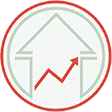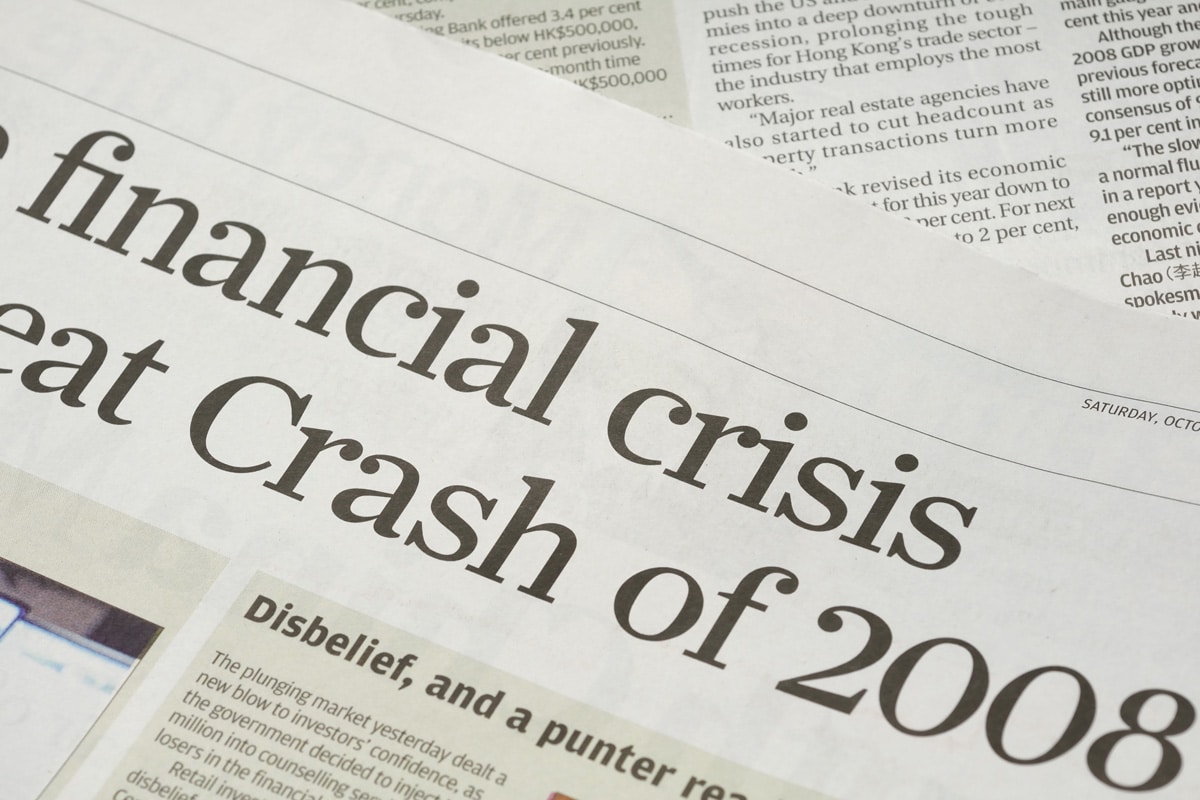Looking Back at the UK's Housing Market Crash of 2008/2009

-
by Property Investments UK
The Property Investments UK editorial team have been researching and writing about the UK's property market for more than a decade.
Some commentators have been forecasting that another housing market crash is likely to happen in the UK. In this article we will look back at the housing market crash of 2008/09 and at what we might learn from it.
What is a Housing Market Crash?
A housing market crash can be defined as an event when residential property prices fall by a large amount within a short period. However, there’s no formal or official definition of exactly what comprises a housing market crash. One definition of a housing market crash might be when house prices fall by 15-20% or more within 12 months, but this is only one opinion.
When Have Housing Market Crashes Happened in the UK?
On the basis that there is no formal definition of a housing market crash, it is difficult to say when housing market crashes have occurred in the past. There have been a few periods when UK house prices have fallen, however.
In recent decades many experts agree that there have been what could be called housing market crashes in the UK in the mid-1950s, the mid-1970s, the early 1980s and early 1990s and a particularly notable crash around 2008/09.

Access our selection of exclusive, high-yielding, off-market property deals and a personal consultant to guide you through your options.
When Will House Prices Crash?
Expert opinions are divided on this. Some experts do not believe that a housing market crash is inevitable. However, some experts believe that they are inevitable due to the boom and bust nature or cyclical nature of the property market and so will occur periodically.
The 18-year property cycle is a theory widely attributed to land economist Fred Harrison. Fred Harrison suggests that evidence of the 18-year property cycle in the UK property market dates back around 300 years. A similar cycle also occurs in other countries.
Fred Harrison is credited with accurately predicting the 1990 and 2008 property market crashes.
Read More:
What Causes a Housing Market Crash?
Low Property Prices and Increasing Incomes
It’s often believed that the conditions for a housing market crash start to develop shortly after recovery from the previous housing market crash. The conditions created by that crash gradually led to a housing market bubble.
Following a housing market crash property prices are low in relation to personal incomes. If there has been a period of economic recession interest rates may also be low making mortgages more affordable. As incomes continue to rise people become keen to buy a home or upgrade to a larger one.
Government Intervention
Additionally, governments may introduce quantitative easing measures to stimulate the economy in a recession. They may offer tax incentives or concessions, such as stamp duty cuts and government-backed loans, to stimulate the housing market.
House prices then begin to rise again, gradually at first before quickening in pace. Prospective house buyers feel that they must buy now before prices become unaffordable. Investors and speculators are attracted to buy by the large capital gains which seem achievable.
Bank Lending Policies
In response to buyer demand banks become more willing to lend for mortgages. They may also loosen their lending criteria, and lend higher loan-to-values (LTVs), a greater multiple of a borrower’s income, and also become willing to lend to borrowers with lower credit ratings.
House Prices Become Unsustainable
These conditions can lead to many borrowers borrowing more than they can really afford to repay and make unrealistically high offers in order to secure a property. Houses may sell within days, and for more than the asking price. The housing market overheats and price rises become unsustainable.
If inflation in the housing market is associated with wider price inflation governments may intervene. By, for example, withdrawing buying incentives and raising the interest rate.
Supply and Demand Become Unbalanced
Eventually, the housing market begins to falter. Prospective buyers can no longer afford to buy and withdraw from the market. Buyers who have overstretched themselves default on their mortgages. Sellers who need or who are forced to sell drop their asking prices substantially.
As the supply of property for sale increases and demand falls prices drop sharply to find a new level. This can lead to a housing market crash.

The 2008/09 Housing Market Crash Explained
Now let us look more closely at how it is thought the 2008/09 housing market crash occurred.
Origins: The 1990s Market Crash and Subsequent Recovery
Some experts believe that the 2008/09 crash had its origins in the 1990s. After this crash, relatively low property prices encouraged more people to buy and attracted more investors into the property market. This caused prices to rise notably again.
However, the primary cause of the 2008/09 housing market crash was most likely the global financial crisis which occurred between 2007 and 2009. This had its origins in the property market and started in the USA.
The Sub-Prime Mortgage Market in the USA
During the early 2000s US house prices were on the rise and US banks became increasingly keen to expand their mortgage lending activities. This, together with a degree of financial deregulation, led them to become more active in the subprime mortgage market.
Sub-prime mortgages include loans to borrowers with poor credit history, at high-income multiples, at high LTVs and on properties which are not usually mortgageable. Sub-prime loans involve a high risk of borrower default, but the higher interest rates charged are intended to compensate the lender for the additional risk.
The US Housing Market Bubble – and Crash
As the 2000s progressed a housing market bubble was developing in the US. As early as 2006 house prices had become unaffordable and sales were declining. Additionally increasing numbers of borrowers, particularly those with sub-prime mortgages, found their repayments were unaffordable and began to default on them. Lenders began to repossess properties and attempted to sell them to recover their losses. Prices crashed and it became clear that many of these losses would never be recovered.
The Global Financial Crisis
During the same era, and to facilitate this expansion in lending, US merchant banks packaged up sub-prime mortgages into financial instruments which could be bought and sold. These included derivatives known as collateralised debt obligations or CDOs.
Following the long-standing belief that property is a safe investment banks worldwide bought these financial instruments. Often, perhaps, without fully understanding the nature of the underlying sub-prime lending.
The global financial crisis came to a head by 2008 and banks around the world realised that they would lose money on these investments. And, not only that, they would lack sufficient liquidity to keep doing business or even face bankruptcy themselves.
The Involvement of UK Banks
The impact was felt particularly hard in the UK as many UK banks, including high street names, had invested heavily in US sub-prime loans via these financial instruments.
The situation was also perhaps exacerbated in the UK by the lending policies of some of the UK banks themselves. Some of these were active in sub-prime lending too, or had loosened their previously prudent lending criteria by offering high-income multiple loans or high LTV loans, such as 100%-plus mortgages.
The 2007/08 UK Banking Crisis
The crisis that began around 2007 came to a head in 2008. Faced with a situation where several banks were (or could) become insolvent the UK government acted to bail out banks (at an estimated cost of £1 trillion) and take some of them into public ownership. Savers’ deposits were protected and bad or toxic loans were written off allowing the banks to continue in business.
The Credit Crunch
The global financial and banking crisis had a direct and immediate impact on the UK housing market.
In what became known as the credit crunch banks became much less willing to lend money, including lending for mortgages. They tightened their lending criteria, became more selective regarding borrowers’ financial circumstances and reduced their maximum LTVs, often to less than 80%. The UK government later introduced rules requiring banks to take a more prudent approach to mortgage lending.
Faced with a situation where potential house buyers could only borrow less money, or could even not borrow at all, house prices declined resulting what has been described as a housing market crash. Some property owners found their properties were worth less than they had paid for them, ie. they were in negative equity.
The wider global economic recession, encompassing other factors such as a rise in oil prices, compounded the situation. As did the resultant ‘feel bad factor’ which made prospective house buyers reluctant to buy in case the bottom of the market had yet to come.

How Bad Was the 2008/09 Housing Market Crash?
How much did prices drop during the 2008/09 housing market crash? Broadly the UK housing market crash occurred between the beginning of 2008 and spring 2009. The then-record average house price of around £190,000 at the end of 2007 had dropped to around £154,500 in the spring of 2009. (UK House Price Index figures.)
The highest annual rate of decline in house prices occurred in February 2009 when average house prices had fallen by 15.6% in just one year.
After a slight recovery, a period of housing market price stagnation followed. Between 2010 and 2013 house prices broadly stagnated, changing only around 1-2% annually at most. House prices did not regain their 2007 record of around £190,000 until late 2014, over seven years later. A slow recovery then began with house prices gradually rising towards the end of that decade.
How Much Have Prices Risen Since 2008/09?
From 2020 onwards, during the Covid pandemic, house prices began to rise sharply again. In both mid-2021 and mid-2022 annual house price rises were running at over 13%. A slowdown then followed and by summer 2023 the rate of annual house price increases was only 0.8%.
Summarising the 2008/09 housing market crash overall: The average house price of £190,000 before the crash dropped to £154,500 at the lowest point of the crash. It then recovered and reached approximately £293,000 by the middle of 2023.